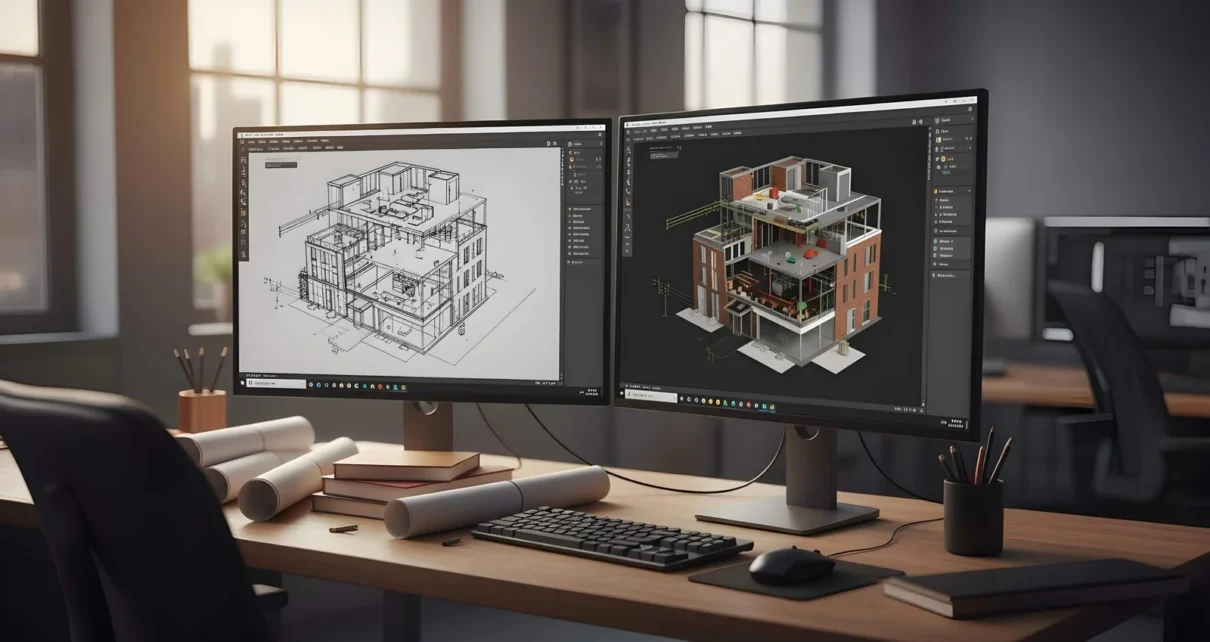You have a decade of immaculate 2D CAD drawings for a building. Every line, circle, and hatch is well-executed. Then comes the client: “We need a full, intelligent 3D BIM model for our renovation.” Now all those clean drawings feel like only half of the picture. Where do you start?
CAD is literally just a drafting board, geometry created from lines and arcs. BIM is an entirely different process. Intelligent objects, integrated with information, create a virtual database of the building that integrates design, construction, and operations. We shouldn’t be surprised by the transition happening in the AEC industry. BIM allows for collaboration, clash detection, cost calculators, and long-term management that AutoCAD Drafting Services alone does not support.
While the benefits seem obvious, it isn’t always that easy. There are a variety of technical issues, as well as organizational issues related to CAD to BIM services. The changes may seem hard, but not impossible. This blog will discuss these issues and, more importantly, ways to overcome them.
What Does it Mean by CAD to BIM Conversion?
Before we dive deeper, it is important to grasp the concept of CAD to BIM conversion before delving into challenges.
CAD – Computer-Aided Design
CAD, a digital drafting tool that has been utilized for decades. It represents geometry like lines, arcs, and symbols to illustrate 2D plans and sections. CAD is a precise form of drawing, but lacks intelligence because what is represented is just a representational drawing.
BIM – Building Information Modeling
Unlike CAD, BIM is more than 3D modelling. It creates a data-rich digital twin of a building. Walls, doors, beams, and ducts are not simply drawings in the model; they are intelligent objects or components that are linked with specifications, materials, and quantities in addition to lifecycle data.
CAD to BIM Conversion
It means converting legacy 2D CAD drawings into intelligent 3D BIM models. This conversion is about more than just geometry recreation; it’s also about building data into the model that will allow the model to be used during design, construction, and operations.
Important Cases of Usage
- Renovation & Retrofit Projects: Transforming legacy drawings into BIM for better accuracy in the planning phase.
- Modernizing Legacy Drawings: Moving decades of CAD archives into a BIM environment.
- Design Standardization: To ensure a consistent, data-driven model across the project(s).
- As-Built Documentation: Transforming accurate representation of the facility into a digital database, valuable to facility management.
Therefore, CAD to BIM services serve as a connection point between the past and future project delivery, unlocking efficiencies, accuracy, and collaboration for AEC professionals.
Common Challenges in CAD to BIM Conversion
Moving from CAD to BIM seems easy on paper, take a 2D drawing, turn it into a 3D model, and you’re done. In practice, the process is much more complicated. AEC construction professionals face a unique set of technical and organizational obstacles that can build or kill the project.
Data Quality and Inconsistency
- Many CAD files are old, incomplete, and contain drafting issues.
- The lack of standardization with layers, line types, and annotations confuses conversion.
- The end result is wasted time in cleansing data prior to modeling.
Loss of Information in the Conversion Process
- CAD drawings contain geometry and no embedded intelligence.
- Critical aspects of the details, like material specification, dimensions, or MEP, will frequently not be found.
- This results in missing intelligence in the BIM model and less value for downstream use.
Complexity in Large-Scale Projects
- Translating accuracy across architecture, structure, and MEP systems increases complexity in the conversion process
- Coordinating data from multiple disciplines while managing large file sizes can be more difficult.
Software and Format Compatibility
- CAD and BIM applications do not always interact well with each other.
- It is common that exporting/importing between DWG, RVT, IFC, etc., creates loss of information and/or inaccuracies.
Shortage of Trained Staff
- BIM applications require specialized training, and not everybody on the AEC project team have that specialized knowledge.
- Modelers may misinterpret 2D CAD drawings during the conversion process, which leads to inaccuracies.
Timing and Budget
- Manual re-modeling is labor-intensive and time-sensitive.
- Many AEC firms are simultaneously trying to deliver their project under a short deadline and a tight budget, which makes it difficult to appropriately convert.
For the AEC professionals, these factors are not only technical issues, but also affect deliverables, client satisfaction, and ultimately the success of the project. Acknowledging those challenges is the first step to providing solutions to them.
Read More : Boost Productivity with Remote Architects: Resolving Workflow Bottlenecks
Best Practices for an Effective CAD to BIM Conversion Service
A proper CAD to BIM conversion is more than a flat transfer of drawings; it’s the creation of a model that serves the intended purpose. The desired end goal could be facility management, possible renovations, clash detection, or standardizing the design process. Whatever it is, knowing the end game is critical so the model can be developed to the correct detail and data.
Based on best practices, here are some suggestions for techniques that AEC design professionals can utilize:
- Clean, Clean, Clean: The quality of your BIM model relies strictly on the quality of the CAD files. Remove duplicate lines, broken references, and develop a standard layer style before migrating.
- Do Not Recreate, Re-think: CAD is simply a reliable underlay, not a final geometry as a basis for measurement. For intelligent BIM object creation purposes, simply trace over the drawings for processing rather than directly importing the linework.
- A Sequential Process: Partition the process into multiple stages, first the structural elements, then the architectural components, and then the MEP systems. This minimizes complexity and allows for superior coordination.
- Quality Control: Introduce a comprehensive QC process. Check geometry and associated metadata, and ensure you are following the BIM Execution Plan (BEP). Frequent checking ensures that any issues are resolved sooner and do not incur large amounts of rework later.
When firms have a clear vision of purpose that is aligned with a disciplined workflow, the use of CAD to BIM services can be more lucid, efficient, and reliable.
Benefits of Successful CAD to BIM Conversion
When the approach is right, CAD to BIM conversion can not only modernize project drawings but also completely change the way we deliver and manage them. The benefits can be extremely worthwhile for both the project team and the client.
- Improved Coordination and Clash Detection: BIM integrates architecture, structure, and MEP systems into a single model. This provides an opportunity for collaboration in discovering clashes. It becomes an expensive problem on-site if clashes are not resolved in the early stage.
- Better Visualization for Stakeholders: Transitioning from 2D lines to 3D intelligent models allows clients, contractors, and facility managers to view clear design intent, diminishing misinterpretations.
- Better facility management: Data-rich BIM models support lifecycle management. Each wall, pipe, and fixture has information attached to it that is beneficial for operations, maintenance, and future renovations.
- Less Rework and Long-Term Savings: Less error and better documentation lead to a reduction in rework. Less rework means fewer issues, which leads to time saving, budget control, and happier clients.
Therefore, you will find that a thorough CAD to BIM conversion provides immediate benefits to the project, while also setting a new standard for smart building management for the future.
Final Thoughts
Choosing to convert CAD files to BIM is not just a technical task, but a strategic move to facilitate more data-rich project delivery. Resolving challenges quickly, whether they relate to data and information inconsistencies, resource gaps, etc., helps mitigate the risk of project delays and expensive rework early in the project delivery process.
When structured, purposeful planning, standardized workflows, and a knowledgeable team of experts, firms can turn static AutoCAD Drafting Services into dynamic BIM models to generate value for the entire building lifecycle. From an AEC perspective, this translates to better collaboration, reduced errors, and long-term efficiencies. Hence, a successful conversion of CAD to BIM is the bridge between the old draftsman and a future of building with intelligence.




